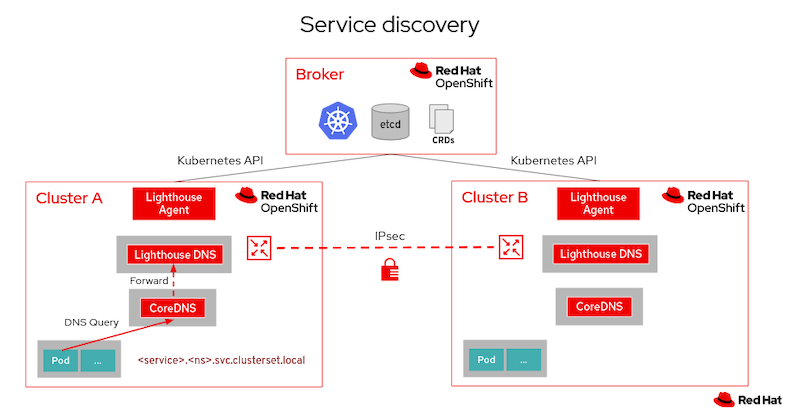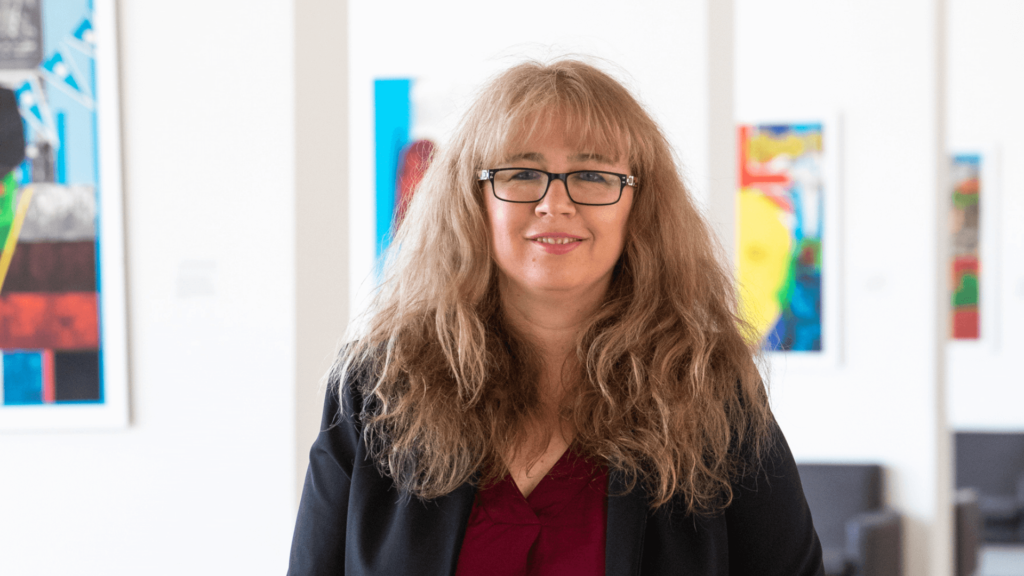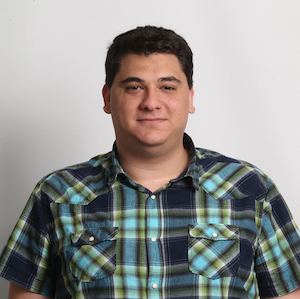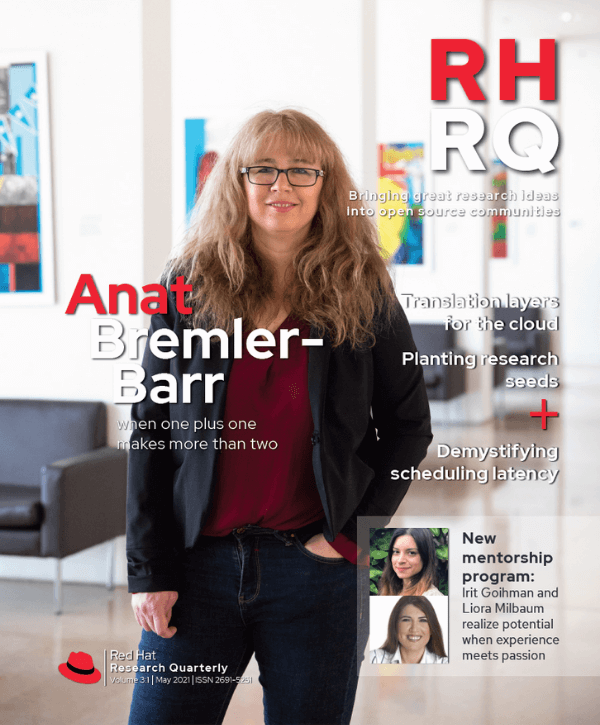
Red Hat Research Quarterly
When one plus one makes more than two: how open source builds a bridge between universities and industry

Red Hat Research Quarterly
When one plus one makes more than two: how open source builds a bridge between universities and industry
Research Director and RIG leader for Israel Idan Levi speaks with Anat Bremler-Barr, Professor in the School of Computer Science and Vice Dean of the Efi Arazi School of Computer Science at the Interdisciplinary Center, Herzliya, Israel (IDC).
Article featured in
Research Director and RIG leader for Israel Idan Levi speaks with Anat Bremler-Barr, Professor in the School of Computer Science and Vice Dean of the Efi Arazi School of Computer Science at the Interdisciplinary Center, Herzliya, Israel (IDC). Before joining the faculty of IDC, Bremler-Barr co-founded a company to provide systems that protect against Denial of Service attacks. It was acquired by Cisco systems in 2004. Her research interests are in computer networks and distributed computing, with an emphasis on security.

—Anat Bremler-Barr
Idan Levi: What is the role of the IDC—and your role in particular—in supporting and expanding the open source community in Israel?
Anat Bremler-Barr: I will answer from my academic and educational perspective: I want to expose my students to the open source community and encourage them to be part of it. As open source becomes the new industry standard, it is expected by software companies that developers will have the background and skills required to utilize the potential of that field. I want the students to have up-to-date knowledge in today’s open source tools as part of their education.
Open source is all about the collaborative method of software development. Students, in their studies here, rarely work in groups. However, in industry, software development is a group effort. Hence, while experiencing open source development, they get a chance to learn the skills to develop in collaboration. While working on an open source project, students build a work portfolio that is public in GitHub, which can help them when they begin to interview for jobs.
Idan Levi: What do you think industry partners and universities could do to help the open source community grow?
Anat Bremler-Barr: I think every graduate of a computer science program should have experience with open source as part of the curriculum and be part of an open source project. Philosophically, I feel that the open source ethos is very close to the ethos of academia: it’s the collaborative effort of the community that makes progress for human knowledge and the general good. This openness is done without compromising the possibility of making money from work and effort. In open source, for example, businesses can succeed by using the service model, and academia is responsible for many patents and start-ups.
“In many cases it can be hard to collaborate with companies, but when you have a framework to do it, you get one plus one adding up to more than two.”
Idan Levi: How do you see open source being part of the curriculum? The first thing that comes to my mind is UC Berkeley, inventing DNS and FreeBSD and really laying the groundwork for all of the open source collaboration around technology. How can universities do this today?
Anat Bremler-Barr: I think it should be integrated in mandatory courses. In operating systems, you should understand the internal elements of Linux®—see how they work and how it was built. In networking you should speak about, say, Kubernetes, OpenShift, things like that. It should be part of the curriculum.
The main problem is that open source projects are usually so big that it’s hard for a student to contribute and understand the whole project. I think it can be done if we invest in it and help students understand the process, the environment, and the general framework, and then help them contribute in something small.
Idan Levi: What about universities choosing something of their own to develop? For example, SPARK started at the University of Southampton. Is that something we can do in Israel?
Anat Bremler-Barr: I’m sure. We have very experienced students in Israel because some of them begin studying after they’ve been in the army or worked in industry. I think at the IDC in particular we include a pragmatic approach along with the theoretical. We have a spirit of innovation, and we are more flexible and open to collaboration. It’s important to have all the flavors of computer science: the pragmatic, the theoretical, the innovative, and anything in between.
Idan Levi: Has that belief affected how you choose your PhD students? Will you do something different from more traditional, research-oriented universities?
Anat Bremler-Barr: I don’t think there is a difference there. The PhD students are all over the spectrum. You need to have theoretical faculty and students, because some of them will make the biggest breakthroughs. But you also need the more pragmatic faculty and students.
From my experience, the theoretical foundation is very important even if you wish to pursue an industry career. The theoretical foundation of computer science shapes the way you approach problems. It gives the ability to think abstractly and concentrate on the essence of the problems. Nonetheless, I think that you also need to expose the students to up-to-date practical tools and paradigms. That is why IDC now provides a dual track in Computer Science and Entrepreneurship.
Idan Levi: What about industry? What has it been like to engage with different companies to support open source?
Anat Bremler-Barr: Right now in Israel the government is investing in helping academia and industry work together. In many cases it can be hard to collaborate with companies, but when you have a framework to do it, you get one plus one adding up to more than two. I do organize a workshop, “Project with the Industry,” with companies that are part of our industrial affiliation program (IAP), in which Red Hat participates.
There is a lot of power in academia, because you have a student that’s eager to get experience, and they need it for their portfolio. You need to invest in them, and then they will give back to the open source community, and all will benefit from that. Within the open source community, collaboration is very easy. It’s very natural. I am very proud of our collaboration with Red Hat. We have a very fruitful collaboration in very different aspects. We have a very successful project from a master’s student contributing to the CEPH open source project (bit.ly/cephobjectstorage), and the mentor was from Red Hat, for example.
We also have workshops on open source that started during the summer semester of 2020, when Red Hat’s Beyond platform offered a class on open source development in conjunction with the IDC (see “Combining experience with passion,” in this issue). The goal was to give undergraduate students an inside taste of development practices in the industry. The workshop was very successful, and we received thank you letters from students who appreciated the investment from the organizers and from the Red Hat engineers who participated as mentors.
Idan Levi: A master’s student at IDC is doing a thesis with the cooperation of Red Hat. The subject is “Kubernetes optimized service discovery across clusters” (bit.ly/kubernetesclusters). What can you tell us about the background of how this work came to be and how it’s going?
Anat Bremler-Barr: The student, Daniel Bachar, is doing the project under the supervision of Prof. David Hay from the Hebrew University and myself. He has and will continue to contribute code to the Submariner (submariner.io) project.
Kubernetes can be combined into different clouds and different clusters, and the same service can be found in different places in different clusters. Today, the way they choose, because applications today are done as microservices, you go from one service to another service. And then you choose whether to use the next service because you have it in a different cluster. If it is in your cluster, you probably will choose it. But if you need to go out, then you should think about the cost and the latency. We try to suggest an algorithm that will optimize both the cost and the latency. We wanted to combine it with DNS so it will be integrated very, very simply, without many changes in the framework.

Idan Levi: A big part of this project has been done in conjunction with the open source community and the SIGs. This is a new approach—at least, it’s the first time that I have seen something like that. What was that like?
Anat Bremler-Barr: For me it’s fascinating because one of the problems, I think, in academia is that you think about an algorithm, but then you must show it works. So you do a simulation, but you cannot implement it in real life. Now we have a chance to implement it in real life. It’s a big problem, because it gives an advantage to people that have worked in big companies like Google or Microsoft. They have a network that they can play with and show results. Those of us in the university don’t have a big network to play with.
So for me it was very effective. The fact that we can implement it in an open source project is very attractive. It’s a win-win situation. And from another perspective, you see that the big companies attract many students and employees. We have more and more problems finding teachers and teaching assistants and staff for our applied computer science courses. The theoretical experts we can find. The problem is the applied computer science students can earn a lot of money in the industry. In some sense, the industry is chopping down the tree they are sitting on.
Idan Levi: It’s like overfishing. When you catch all the little fish, they don’t reproduce. You don’t have teachers of tomorrow to teach the next generation.
Anat Bremler-Barr: Yes. For example, when I’ve been looking for a TA for a course, many people on staff tell me that their employers won’t let them go to classes. In the past a business might say, “It’s good for you—you can increase your understanding and develop as an employee.” Now they do not.
“Really, to do great stuff, it takes a lot of effort and collaboration. Collaboration should be the default.”
Companies want to educate their employees on their own, but I think each of us should stick to what we know best. Leave the teaching to the university, but collaborate with us, help us, and be part of us. Fund us, give us projects—that’s great. But you should not get your education from industry because they don’t think about the welfare of the student. They are focused on the welfare of the company.
Idan Levi: So what would you recommend that industry do to make this collaboration better? You’ve been on both sides of this, as the founder of a start-up company that was acquired by Cisco as well as an educator.
Anat Bremler-Barr: Well, part of the problem is also the universities. We are very different at IDC, but at many Israeli universities the rules around intellectual property (IP) are very complex. The bureaucracy can be stifling. In industry, I think the culture needs to change, and more emphasis needs to be put on collaboration. I see a little bit of change already.
Every year I do a workshop with the industry. Companies come and bring projects to the students. Some companies start to bring me lawyers. I tell them, “I cannot do this with lawyers; they complicate the situation.” IDC does not take any IP. It belongs to the student, and the student can allow the company to use it. That’s it. I don’t want to take anything from the student. The student is doing the project, and I want the company to use it. I cannot read all the contracts and then pay our lawyers to speak to their lawyers and nothing gets done. No. I want it simple and collaborative. Really, to do great stuff, it takes a lot of effort and collaboration. Collaboration should be the default.
Idan Levi: Just a note here: Red Hat might be unique in the approach it takes to IP. We make no claims to IP when we work with researchers and students, as long as it’s open source. But back to industry: In many cases, industry focuses on understanding what customers need. Is it security? Ease of use? Automation? How does being customer-centric translate into your world?
Anat Bremler-Barr: Well, we in academia have the privilege to think about problems in a fresh way. We can make radical suggestions and radical changes if overall, in the long run, they are better. In this sense, we are different from industry, which needs to think short term and focus on their paying customers. It does not mean that we do not think about the customers, but we can also concentrate on long-term satisfaction.

Idan Levi: Can we conclude with your observations on increasing the participation of women in computer science? As a woman in technology with a significant career, you are a role model and, I’ve heard, an inspiration to other women in the field. What do you think about the way that women are included in the academic world and industry?
Anat Bremler-Barr: It is clear that there is room for improvement in the number of women that are included in academic work and the industry. Though when I entered the Red Hat office in Ra’anana, I was amazed to see the high percentage of women, and it struck me to see that there were women in all the ranks in all ages. Unfortunately, this is not the typical case.
I am proud to note that the Efi Arazi School of Computer Science at IDC has a high percentage of female students. The proportion of female students has risen from an already high 30 percent in the 2019-2020 year to an unprecedented 37 percent in the 2020-2021 year.
The increase can be attributed to two main factors. First, it reflects a general trend around the world, with increasing numbers of women studying the computer sciences, attracted at least in part by the availability of well-paid jobs in the field. And second, it reflects a determined push by the Efi Arazi School and IDC Herzliya in general to encourage more female students to enroll in computer science. We hold events annually targeted towards encouraging women to join the school, and an active recruitment program continues throughout the year. In addition, 30 percent of faculty members are women, a significantly higher percentage than in other universities (around 15 percent in Israel), which helps attract more female students.
That said, I do have a hard time finding a female TA in operating systems. For 20 years I didn’t have a female TA. Sometimes I begged! “Please come. You will be so perfect as a TA.” The last one I had was 20 years ago, and that is a shame, really a shame.
More like this
Václav Matyáš, Professor with the Centre for Research on Cryptography and Security at the Faculty of Informatics at Masaryk University.
Sanjay Arora is a data scientist at Red Hat and a member of the Greater Boston Research Interest Group with particular interests in AI and machine learning. For RHRQ he interviewed Kate Saenko, a faculty member at Boston University and consulting professor for the MIT-IBM Watson AI Lab, about managing bias in machine learning datasets and the problems that remain unsolved.
We spoke about the importance of data sharing and privacy preservation, in both scientific and computer technology domains, with James Honaker and Mercè Crosas, two of Harvard’s leaders in these fields.
We invited Red Hat Principal Kernel Engineer Toke Høiland-Jørgensen to interview Anna Brunström, currently a Full Professor and Research Manager for the Distributed Systems and Communications Research Group at Karlstad University, Sweden. Prof. Brunström has a background in distributed systems, but her main area of work over the last years has been in computer networking. Their wide-ranging conversation covers programmable networking, open data, diversity in IT fields, and more.
Red Hat Research University Program Manager Matej Hrušovský interviewed Barbora Buhnová, Associate Professor and Vice Dean for industrial partners at Masaryk University, Faculty of Informatics in Brno, Czech Republic. She is also the chair of the Association of Industrial Partners of Masaryk University, Faculty of Informatics, and is a co-founding and governing board member of […]
Dr. Michael Zink is Professor of Electrical and Computer Engineering at the University of Massachusetts, Amherst. In addition to publishing and teaching, Dr. Zink has participated in several projects providing distributed systems and virtual networks for research and education, including GENI and ExoGENI (2007-2021), Cloud Lab (2014-2021), and now the Open Cloud Testbed (OCT) since […]
RHRQ asked Professor Ayse Coskun of the Electrical and Computer Engineering Department at Boston University to sit down for an interview with Red Hatter Marcel Hild. Professor Coskun is one of the Principal Investigators on the project AI for Cloud Ops, which recently won a $1 million Red Hat Collaboratory Research Incubation Award. Their conversation […]
RHRQ asked Brno research manager Matej Hrušovský and Red Hat quality assurance engineer Pavel Tišnovský to talk with long-time collaborator Tomáš Černý, a native of the Czech Republic now teaching at Baylor University in Waco, Texas. Prof. Černý was in Brno recently as part of his highly successful student research initiative, which brings Baylor students […]
Security researcher and professor Daniel Gruss is an internationally known authority on security vulnerabilities. Among the exploits he’s discovered with his research team are the Meltdown and Spectre bugs, and their software patch for Meltdown is now integrated into every operating system. Frequent collaborator Martin Schwarzl, a PhD student in Daniel’s CoreSec group at Graz […]



